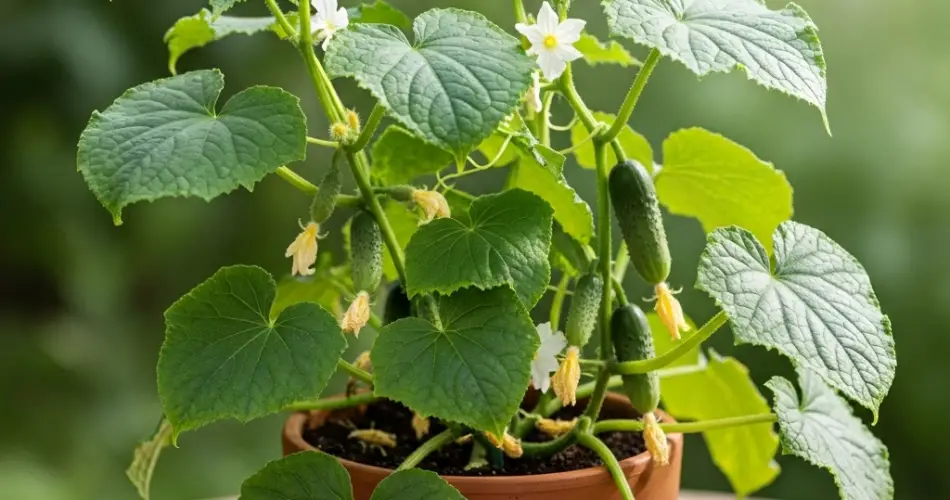If you’re dreaming of growing fresh, crisp cucumbers at home but don’t have a traditional garden space, deep container gardening is a smart and rewarding option. With the right setup, you can grow healthy cucumber vines in pots on patios, balconies, rooftops, or any small outdoor area. Deep containers provide the root space cucumbers need and offer excellent control over growing conditions, making them perfect for home gardeners of all skill levels.
In this guide, you’ll find the most effective tips to help you grow a productive cucumber crop in deep containers—from choosing the right pot to harvesting the perfect cucumbers.
Why Deep Containers Work for Cucumbers
Cucumbers have strong root systems that spread deep and wide to support vigorous vine growth. Growing them in deep containers allows ample space for root development, resulting in healthier plants, better water retention, and increased yields. Additionally, deep containers reduce the risk of root-bound plants, which can limit growth and productivity.
Other advantages of deep container gardening include:
-
Better drainage control
-
Protection from soil-borne pests
-
Improved soil temperature regulation
-
Flexible placement in limited spaces
Choosing the Right Container
Selecting the right container is the first step to success. Cucumbers need room to grow, so avoid small pots that can quickly become overcrowded or dry out.
Container requirements:
-
Depth: At least 12–16 inches deep
-
Width: A minimum of 12 inches across for each plant
-
Capacity: A 5-gallon container works well for one plant
-
Material: Plastic, terracotta, fabric grow bags, or food-grade buckets all work, as long as they have proper drainage
Drill several holes at the bottom of your container to ensure excess water can escape, preventing soggy soil and root rot.
Picking the Right Cucumber Variety
Not all cucumbers are created equal when it comes to container gardening. Some grow long vines that need a lot of vertical space, while others are compact and bushy—ideal for small areas and containers.
Recommended cucumber varieties for deep containers:
-
Bush Pickle – Small, compact plant perfect for tight spaces
-
Spacemaster 80 – A bush variety bred for container growing
-
Patio Snacker – Compact vines with sweet fruit
-
Lemon Cucumber – Round, yellow fruit with a mild taste and manageable vine growth
-
Marketmore – Requires trellising but adapts well to container life
Choose bush varieties if space is limited, or vining types if you can provide vertical support.
Creating the Perfect Soil Mix
Cucumbers love fertile, well-draining soil that retains moisture without becoming waterlogged.
Ideal soil blend:
-
50% high-quality potting soil
-
30% compost or well-rotted manure
-
20% perlite or coconut coir for aeration
Before planting, mix in a balanced organic fertilizer or a slow-release granular feed to help young plants establish strong roots. Cucumbers are heavy feeders, so nutrient-rich soil is key.
Planting and Positioning
Once your container and soil are ready, it’s time to plant.
-
Fill the container nearly to the top, leaving about 1–2 inches of space.
-
Sow seeds directly or transplant healthy seedlings. If sowing seeds, place 2–3 per pot and thin to the strongest one after sprouting.
-
Water deeply after planting to help roots settle in.
Place the container in a location that receives 6 to 8 hours of sunlight each day. Cucumbers thrive in full sun, and deep containers help keep roots cooler and hydrated longer.
Supporting Vining Growth
Even in containers, cucumbers benefit from vertical growing. Supporting your plants keeps them off the soil, improves airflow, and makes harvesting easier.
Support ideas:
-
Bamboo stakes
-
Small trellises
-
Tomato cages
-
Wall-mounted nets or strings
Tie vines gently to the support as they grow. Bush varieties may not need trellising, but indeterminate types will.
Watering and Feeding
Deep containers hold more soil and moisture, but cucumbers still require consistent watering—especially during flowering and fruiting.
-
Water when the top inch of soil feels dry, ideally in the morning.
-
Avoid soaking the leaves, which can lead to disease.
-
Fertilize every 2–3 weeks with a water-soluble plant food or organic compost tea to support fruit production.
Mulching the top of the soil with straw or shredded leaves helps retain moisture and prevents rapid drying on hot days.
Pest and Disease Prevention
Container-grown cucumbers tend to have fewer pest problems, but vigilance is still important.
Common pests to watch for:
-
Aphids
-
Cucumber beetles
-
Spider mites
Use neem oil or insecticidal soap as needed. Remove any diseased leaves promptly and avoid overcrowding to ensure good airflow around the plants.
Harvesting Cucumbers
Cucumbers grow fast—check daily once fruits begin to form. Harvest them when they’re firm, smooth, and the right size for their variety.
-
Pick regularly to encourage more fruit production.
-
Use scissors or garden shears to avoid damaging the vine.
Don’t let cucumbers become overripe, as this signals the plant to slow down production.
Final Thoughts
Growing cucumbers in deep containers is a fantastic way to produce fresh, flavorful food in small or unconventional spaces. With the right container, soil, and support, you can enjoy a healthy cucumber harvest right on your porch, balcony, or patio.
This method is perfect for beginners and urban gardeners who want maximum yield with minimal space. Start with one deep pot and watch your cucumber vines climb—and thrive.



